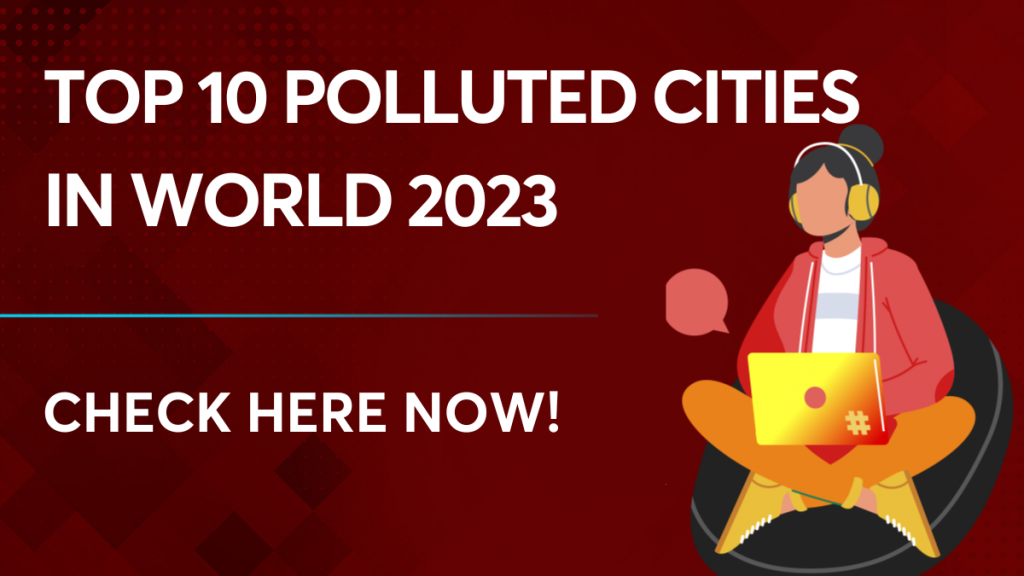The issue of air pollution is a growing concern worldwide, with millions of people suffering from its adverse effects. In 2023, cities still struggle to maintain healthy air quality, despite efforts to combat pollution.
From Asia to Africa to Europe, these cities are facing significant challenges in reducing pollution and protecting their citizens’ health. Understanding the severity of the situation in these cities is crucial in addressing the global problem of air pollution and taking action to improve air quality for everyone. Based on recent data and studies, this article highlights the top 10 polluted cities in world 2023.
List of the Top 10 polluted cities in world 2023
Here is the list of the top 10 polluted cities in world 2023 highlighting the severity and consequences of the situation.
Dammam, Saudi Arabia
PM2.5: 124.11 µg/m3
According to Smart Air, with a population of 1,252,523 people, Dammam is a city in Saudi Arabia currently considered the world’s most polluted city. As the main administrative centre of the Saudi oil industry, the city’s air is often thick with smog. The primary cause of air pollution in Dammam is vehicle emissions, which severely impact the health of its residents.
Lahore, Pakistan
PM2.5: 111.63 µg/m3
According to Smart Air, with a population of 1,252,523 people, Dammam is a city in Saudi Arabia currently considered the world’s most polluted city. As the main administrative centre of the Saudi oil industry, the city’s air is often thick with smog. The primary cause of air pollution in Dammam is vehicle emissions, which severely impact the health of its residents.
Begusarai, India
PM2.5: 108 µg/m3
Begusarai, an Indian city, has become a hub for smog due to Barauni Thermal Power Station (BTPS), Indian Oil Corporation Limited (IOCL), and Barauni Sudha Dairy industries. The city’s hot climate and poor air quality make it an unpleasant place for those who prioritize their health. The World Health Organization (WHO) has reported that the current concentration of PM2.5 in Begusarai is 9.9 times higher than the recommended limit.
Dhaka, Bangladesh
PM2.5: 84.73 µg/m3
Dhaka, the capital and largest city of Bangladesh, is grappling with a significant challenge of air pollution. The metropolis is expanding rapidly, with nearly 17 million people, a majority of whom live in over 5000 slums. The concentration of PM2.5 in Dhaka’s air is 6.1 times higher than the recommended limit by the World Health Organization. This alarming level of air pollution is compounded by environmental stresses from the city’s overflowing landfills and traffic congestion.
Delhi
PM2.5: 84.39 µg/m3
The high levels of air pollution in Delhi have been linked to various health issues, including respiratory diseases, cardiovascular problems, and even premature death. The government of India and local authorities have been taking steps to address the issue, including promoting the use of clean energy, imposing restrictions on vehicular traffic, and implementing measures to reduce the burning of waste and crop residue. However, more concerted efforts are needed to improve the air quality in Delhi and protect the health of its citizens.
Muzaffarnagar, India
PM2.5: 81.35 µg/m3
Muzaffarnagar, located in the Uttar Pradesh region of India, is commonly referred to as the “sugar bowl” due to its large sugar, steel, and paper industries. While these industries provide employment opportunities to the local population, they are also the primary cause of the city’s poor air quality. To safeguard one’s health, wearing a mask is mandatory in the city. The concentration of PM2.5 particles in Muzaffarnagar’s air is 3.8 times higher than the recommended level, posing a serious risk to the health of its residents.
Kashgar, China
PM2.5: 78 µg/m3
Located between the Pamirs Mountains and a vast desert, Kashgar has a rich history as a prominent trading center. What was once an isolated oasis has transformed into a bustling city with a population of 711,300 as of 2019. However, the city’s air quality is a major concern, with the concentration of PM2.5 particles exceeding the recommended level by 4.5 times. The city has recently been identified as the most polluted city in China, with much of its pollution arising from natural sources.
Baghdad, Iraq
PM2.5: 77.62 µg/m3
Baghdad, the capital city of Iraq, stands as a stronghold of Islamic civilization and Arabic culture. Despite its reputation as one of the world’s most magnificent cities, Baghdad currently confronts challenges including poverty, corruption, displacement, illiteracy, and, most notably, poor air quality. Even outdoors, individuals with heightened sensitivity can suffer from throat irritation and breathing difficulties.
Ghaziabad, India
PM2.5: 74.72 µg/m3
Due to its high health risks, Ghaziabad, a city located in the Uttar Pradesh region of India, should be avoided. The city’s population of 1,729,000 is rapidly increasing, and its famous Oil Engines industry has contributed to its poor air quality. Additionally, power plants, factories, unpaved roads, construction sites, and vehicle emissions are all contributing factors to the city’s air pollution.
Patna, India
PM2.5: 67.20 µg/m3
Located on the southern banks of the Ganges River, Patna is a vibrant city with a rich historical background. However, the city has gained notoriety for having some of the world’s most polluted waterways, including the Ganges River. The air quality is equally concerning, with PM2.5 concentration levels capping at 6.7 times above the recommended limit, making it extremely harmful to live here, particularly for individuals with sensitivity issues.
Top 10 polluted cities in world 2023: FAQs
Dammam, Saudi Arabia, stands first in the Top 10 polluted cities in world 2023 list.
Begusarai, India, is the 3rd most polluted city in the world.
Lahore, Pakistan, is the 2nd most polluted city in the world.
Baghdad, Iraq, is the 8th most polluted city in the world.
Patna, India, comes last in the Top 10 polluted cities in world 2023 list.
